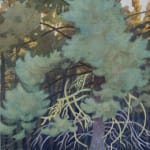
 The painting "Saskatchewan Shade" by Ernest Lindner, circa 1940, portrays a serene woodland scene.
The painting "Saskatchewan Shade" by Ernest Lindner, circa 1940, portrays a serene woodland scene.
Ernest Lindner Austrian Canadian, 1897-1988
Further images
The painting "Saskatchewan Shade" by Ernest Lindner, circa 1940, portrays a serene woodland scene. A central tree with a full, dense canopy is the focal point, set against a backdrop of subtle, layered foliage. The artist has used a soft, muted palette to capture the dappled light and shadow that one would find in a tranquil forest setting.
What stands out in this piece is the almost ethereal rendering of the tree’s root system, which is highlighted in white and yellow tones, contrasting with the darker hues of the surrounding earth and undergrowth. This choice gives a sense of the tree's vitality and interconnectedness with the environment, emphasizing the importance of roots both literally and symbolically.
The canopy is depicted with a range of greens and blues, creating a cooling effect that evokes the feeling of being sheltered under the tree's branches on a warm day. The gentle blending of colors suggests a calm, quiet atmosphere, typical of a secluded spot away from the harsh sunlight.
Lindner’s style here is characterized by fluid, almost dreamlike transitions between forms, which lends a peaceful and timeless quality to the scene. The overall impression is one of harmony with nature and the quiet beauty of the Canadian landscape.




